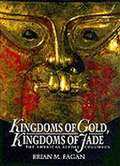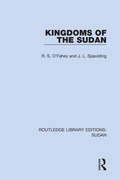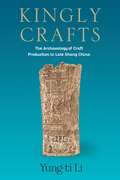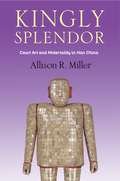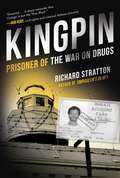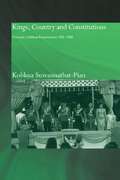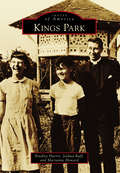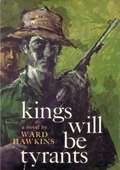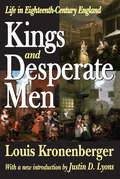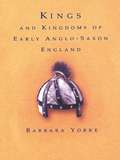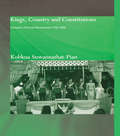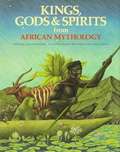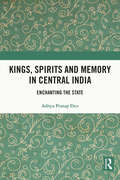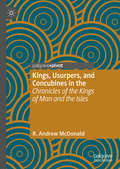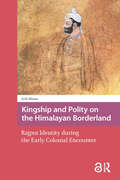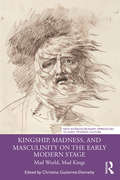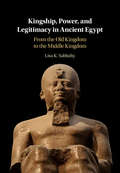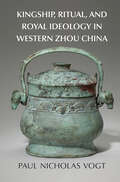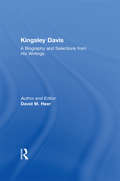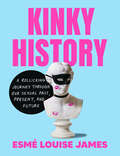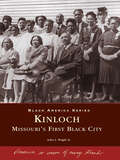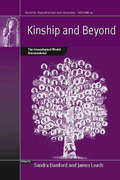- Table View
- List View
Kingdoms of Gold, Kingdoms of Jade: The Americas Before Columbus
by Brian M. FaganAn account of Mesoamerican civilizations.
Kingdoms of the Sudan (Routledge Library Editions: Sudan)
by R.S. O'Fahey J.L. SpauldingThis book, first published in 1974, is a study of the two states which dominated the northern and western regions of Sudan from the sixteenth to the nineteenth century: the Funj kingdom of Sinnār and the Keira sultanate of Dār Fūr. Until now the history of these two states has been neglected in comparison with that of the western states of the Sudanic Belt. The authors spent years researching the documentation of the period and the present book is a concise survey of their findings, comprising history, literature, politics, economics, trade and religion.
Kingly Crafts: The Archaeology of Craft Production in Late Shang China (Tang Center Series in Early China)
by Yung-ti LiThe site of Anyang, the last capital of the Shang dynasty, dated to around 1200 to 1000 BCE, is one of the most important sources of knowledge about craft production in Bronze Age China. Excavations and research of the settlement over the past ninety years demonstrate both the advanced level of Shang craft workers and the scale and capacity of the craft industries of the time. However, materials unearthed in Anyang by different expeditions have since been stored separately in China and Taiwan, making a thorough study of this important aspect of life in Shang China challenging. Despite efforts to integrate the data based on published material, the physical evidence rarely has been considered as a single group.Through a systematic analysis of the archaeological materials available in both China and Taiwan, Yung-ti Li provides a detailed picture of craft production in Anyang and paves the way for a new understanding of how the Shang capital functioned as a metropolis. Focusing on craft-producing activities, including bronze casting, bone working, shell and marble inlay working, lithic working, and pottery production, Kingly Crafts examines the material remains, the technology, and the production organization of the craft industries. Although the level of Shang craftsmanship can be seen in the finished products, Li demonstrates that it is necessary to study workshop remains and their archaeological context to reconstruct the social and political contexts of craft production. Offering a comprehensive investigation of these remains, Kingly Crafts sheds new light on the relationships between craft industries and political authority in the late Shang period.
Kingly Splendor: Court Art and Materiality in Han China (Tang Center Series in Early China)
by Allison R. MillerThe Western Han dynasty (202 BCE–9 CE) was a foundational period for the artistic culture of ancient China, a fact particularly visible in the era’s funerary art. Iconic forms of Chinese art such as dazzling suits of jade; cavernous, rock-cut mountain tombs; fancifully ornate wall paintings; and armies of miniature terracotta warriors were prepared for the tombs of the elite during this period. Many of the finest objects of the Western Han have been excavated from the tombs of kings, who administered local provinces on behalf of the emperors.Allison R. Miller paints a new picture of elite art production by revealing the contributions of the kings to Western Han artistic culture. She demonstrates that the kings were not mere imitators of the imperial court but rather innovators, employing local materials and workshops and experimenting with new techniques to challenge the artistic hegemony of the imperial house. Tombs and funerary art, Miller contends, functioned as an important vehicle of political expression as kings strove to persuade the population and other elites of their legitimacy. Through case studies of five genres of royal art, Miller argues that the political structure of the early Western Han, with the emperor as one ruler among peers, benefited artistic production and innovation. Kingly Splendor brings together close readings of funerary art and architecture with nuanced analyses of political and institutional dynamics to provide an interdisciplinary revisionist history of the early Western Han.
Kingpin: Prisoner of the War on Drugs (Cannabis Americana #2)
by Richard StrattonThis fast-paced sequel to Smuggler's Blues is a harrowing and at times comical journey through the criminal justice system at the height of America's War on Plants.Captured in the lobby of the Sheraton Senator Hotel at LAX following a fifteen-year run smuggling marijuana and hashish as part of the hippie mafia, Richard Stratton began a new journey. Kingpin tells the story of the eight years that followed, through two federal trials and the underworld of the federal prison system, at a time when it was undergoing unprecedented expansion due to the War on Drugs. Stratton was shipped by bus from LA' s notorious Glass House to jails and prisons across the country, a softening process known as diesel therapy. Resisting pressure to falsely implicate his friend and mentor, Norman Mailer, he was convicted in his second trial under the kingpin statute and sentenced to twenty-five years without the possibility of parole.While doing time in prisons from Manhattan's Criminal Hilton to rural Pennsylvania, Virginia, Kentucky, and New York, he witnessed brutality as well as camaraderie, rampant trafficking of contraband, and crimes by both guards and convicts. He first learned the lessons of survival. Then he learned to prevail, becoming a jailhouse lawyer and winning the reversal of his kingpin sentence and eventual release.Kingpin includes cameos by Norman Mailer and Muhammad Ali, and an account of the author's friendship with mafia don Joe Stassi, a legendary hitman from the early days of the mob who knew gangsters Meyer Lansky, Bugsy Siegel, and Abe Zwillman and has insights into the killing of Dutch Schultz and the Kennedy assassinationKingpin is the second volume in Richard Stratton's trilogy, Remembrance of the War on Plants.
Kings Countries & Constitutions - SEA NIP: Thailand's Political Development 1932-2000
by Kobkua Suwannathat-PianProviding a detailed analysis of Thailand's political development since 1932, when Thailand became a constitutional monarchy, until the present, this book examines the large number of different versions of the constitution which Thailand has had since 1932, and explains why the constitution has been subject to such frequent change, and why there have been so many outbursts of violent, political unrest. It explores the role of the military, and, most importantly, discusses the role of the monarchy, which, as the author shows, has been crucial in holding Thailand together through the various changes of regime. The author brings to light original and largely unseen documents from the Public Records Office and US National Archives, as well as drawing upon her extensive knowledge of politics in Thailand.
Kings Park (Images of America)
by Bradley Harris Joshua Ruff Marianne HowardNestled amidst a major commuter train line, a state highway, and picture-perfect views of the Long Island Sound and Nissequogue River, Kings Park balances its small-town feel with an excitingly diverse community vibrancy. Kings Park emerged in the late 19th century as the product of a utopian-inspired farm and the first state psychiatric hospital on Long Island. The community has diverse origins, with its foundation built upon thousands of incoming Irish and Italian immigrant workers and an orphanage for African American children. Throughout the 20th and early 21st centuries, Kings Park gradually evolved into a contemporary Long Island suburb, rebuilding after a traumatic downtown fire in 1917, reaping the benefits of one of the North Shore’s largest state parks (Sunken Meadow), and blossoming into a bustling family-oriented place.
Kings Will Be Tyrants
by Ward HawkinsKings Will Be Tyrants by Ward Hawkins is a 1959 novel about fighting in Cuba. Bernardo Manuel Patrick O'Brien is a former U.S. Marine who winds up fighting for Castro. Though a Marine, he has to deal with the conflict of his heritage, both Cuban and American.REBELS AND LOVERSThey sat side by side on the bank of the stream. In the moonlight, O’Brien could see the oval of her face, the brushed-back hair, the level hazel eyes and the soft mouth. He could see the swelling of her breasts in the open front of her shirt, the slender bare feet dangling in the water, and he could smell the many small odors that named her woman.She was very desirable. It was only in the matter of politics that they were on opposite sides. “I believe there is one matter in which we could agree,” he said softly.The girl met his searching look with a tentative smile.He reached out and put his big rough but oddly gentle hands on her shoulders and pushed her back until she was lying on the ground. She did not resist.But when he bent to put his mouth against hers, she whispered, “I have not done this before.”O’Brien tightened his arms around her. “Then it is time,” he said.Not since Hemingway’s FOR WHOM THE BELL TOLLS has there been such a gripping novel of love and war… “Dramatic, entertaining, highly readable…”—Los Angeles Times
Kings and Desperate Men: Life in Eighteenth-century England
by Louis KronenbergerThe goal of Kings and Desperate Men is to provide a picture of eighteenth-century England up to the French Revolution. Kronenberger's work lies much closer to a social chronicle than an orthodox history, and is more concerned with manners and tastes than with treaties and wars. Kings and Desperate Men reveals what life was like for both aristocrats and commoners: their family lives, experience of larger society, habits, diet, fashions, religion, and artistic tastes. In tracing these topics for both city and country dwellers, he artfully communicates the very real division between the vivacity of London and the regular, fixed, and monotonous character of country life. The division is vital to understanding the age and the transformations it would experience.Yet Kronenberger does not ignore the more traditional historical landmarks. Kroenberger treats the characters of the leading political actors: Walpole, Bolingbroke, Burke, Fox, and Pitt, while providing the reader with a sweeping account of the formation of political parties and constitutional shifts of power between the monarchy and parliament. Students of the period who despair at its political complexities will fi nd much to appreciate in Kronenberger's condensed and easy to understand formulations.As for philosophy, Kronenberger refers to thinkers and ideas as they influence English life; especially Locke and Hume. Their ideas and reputations are explained as part of the character of society. The same is true for economics. More attention is given to the social gains of middle-class shopkeepers and the eighteenth-century zeal for stock speculation than to formal schools of thought. Especially notable is Kronenberger's treatment of both the arts and the artists of the eighteenth century-theatre, opera, music, literature, architecture, and painting.
Kings and Kingdoms of Early Anglo-Saxon England
by Dr Barbara YorkeKings and Kingdoms of Early Anglo-Saxon England provides a unique survey of the six major Anglo-Saxon kingdoms - Kent, the East Saxons, the East Angles, Northumbria, Mercia and Wessex - and their royal families, examining the most recent research in this field.Barbara Yorke moves beyond narrative accounts of the various royal houses to explain issues such as the strategies of rule, the reasons for success and failure and the dynamics of change in the office of king. Sixteen genealogical and regnal tables help to elucidate the history of the royal houses.
Kings for Three Days: The Play of Race and Gender in an Afro-Ecuadorian Festival
by Jean Muteba RahierWith its rich mix of cultures, European influences, colonial tensions, and migration from bordering nations, Ecuador has long drawn the interest of ethnographers, historians, and political scientists. In this book, Jean Muteba Rahier delivers a highly detailed, thought-provoking examination of the racial, sexual, and social complexities of Afro-Ecuadorian culture, as revealed through the annual Festival of the Kings. During the Festival, the people of various villages and towns of Esmeraldas--Ecuador's province most associated with blackness--engage in celebratory and parodic portrayals, often donning masks, cross-dressing, and disguising themselves as blacks, indigenous people, and whites, in an obvious critique of local, provincial, and national white, white-mestizo, and light-mulatto elites. Rahier shows that this festival, as performed in different locations, reveals each time a specific location's perspective on the larger struggles over identity, class, and gender relations in the racial-spacial order of Esmeraldas, and of the Ecuadorian nation in general.
Kings of the Yukon: A River Journey in Search of the Chinook
by Adam Weymouth Harold R. JohnsonA stunning new voice in nature writing makes an epic journey along the Yukon River to give us the stories of its people and its protagonist--the king salmon, or the Chinook--and the deepening threat to a singular way of life, in a lyrical, evocative and captivating narrative.The Yukon River is 3,190 kilometres long, flowing northwest from British Columbia through the Yukon Territory and Alaska to the Bering Sea. Every summer, millions of salmon migrate the distance of this river to their spawning ground, where they go to breed and then die. The Chinook is the most highly prized among the five species of Pacific salmon for its large size and rich, healthy oils. It has long since formed the lifeblood of the economy and culture along the Yukon--there are few communities that have been so reliant on a single source. Now, as the region contends with the effects of a globalized economy, climate change, fishing quotas and the general drift towards urban life, the health and numbers of the Chinook are in question, as is the fate of the communities that depend on them. Travelling in a canoe along the Yukon River with the migrating salmon, a three-month journey through untrammeled wilderness, Adam Weymouth traces the profound interconnectedness of the people and the Chinook through searing portraits of the individuals he encounters. He offers a powerful, nuanced glimpse into the erosion of indigenous culture, and into our ever-complicated relationship with the natural world. Weaving in the history of the salmon run and their mysterious life cycle, Kings of the Yukon is extraordinary adventure and nature writing and social history at its most compelling.
Kings of the Yukon: One Summer Paddling Across the Far North
by Adam Weymouth"Stirring and heartbreaking." - David Owen, author of Where the Water GoesOne man's thrilling and transporting journey by canoe across Alaska in search of the king salmonThe Yukon river is 2,000 miles long, the longest stretch of free-flowing river in the United States. In this riveting examination of one of the last wild places on earth, Adam Weymouth canoes along the river's length, from Canada's Yukon Territory, through Alaska, to the Bering Sea. The result is a book that shows how even the most remote wilderness is affected by the same forces reshaping the rest of the planet. Every summer, hundreds of thousands of king salmon migrate the distance of the Yukon to their spawning grounds, where they breed and die, in what is the longest salmon run in the world. For the communities that live along the river, salmon was once the lifeblood of the economy and local culture. But climate change and a globalized economy have fundamentally altered the balance between man and nature; the health and numbers of king salmon are in question, as is the fate of the communities that depend on them. Traveling along the Yukon as the salmon migrate, a four-month journey through untrammeled landscape, Adam Weymouth traces the fundamental interconnectedness of people and fish through searing and unforgettable portraits of the individuals he encounters. He offers a powerful, nuanced glimpse into indigenous cultures, and into our ever-complicated relationship with the natural world. Weaving in the rich history of salmon across time as well as the science behind their mysterious life cycle, Kings of the Yukon is extraordinary adventure and nature writing at its most urgent and poetic.
Kings, Country and Constitutions: Thailand's Political Development 1932-2000
by Kobkua Suwannathat-PianProvides a detailed analysis of Thailand's political development since 1932, when Thailand became a constitutional monarchy, until the present. It examines the large number of different versions of the constitution which Thailand has had since 1932, and explains why the constitution has been subject to such frequent change, and why there have been so many outbursts of violent, political unrest. It explores the role of the military, and, most importantly, discusses the role of the monarchy, which, as the author shows, has been crucial in holding Thailand together through the various changes of regime. The author brings to light original and largely unseen documents from the Public Records Office and US National Archives, as well as drawing upon her extensive knowledge of politics in Thailand.
Kings, Gods And Spirits From African Mythology (The World Mythology Series)
by Jan KnappertFrom the Book Jacket: This book tells the myths and legends of the peoples of Africa. Africa is a vast continent and its landscape enormously varied, ranging from the great Sahara Desert to dense primeval forest, from snow-capped mountains to the plains of the savannah. The stories in this book have been passed down for generations and are still told and retold today. They include tales of gods, spirits and ghosts; sagas about famous heroes, warriors and royal leaders; and fables about the animals which play such an important part in the everyday life of the countryside. Twelve large color paintings, a full color map and many line drawings illustrate these fascinating tales. "This is an admirable series. The prose is readable, the myths retain their integrity and the illustrations are attractive and contribute to authenticity." - School Library Journal
Kings, Spirits and Memory in Central India: Enchanting the State
by Aditya Pratap DeoPart anthropological history and part memoir, this book is a unique study of the polity of the colonial-princely state of Kanker in central India. The author, a scion of the erstwhile ruling family of Kanker, delves into the oral accounts given in the ancestral deity practices of the mixed tribe-caste communities of the region to highlight popular narratives of its historical polity. As he struggles with his own dilemmas as ethnographer-king, what comes into view is a polity where the princely state is drawn out amidst a terrain of gods and spirits as much as that of law courts and magistrates, and political power is divided, contested and shared between the raja/state and the people. This study constitutes not only an intervention in the larger debate on the relationship between state formations and tribal peoples, but also on the very nature of history as a knowledge practice, especially the understandings of power, authority and sovereignty in it. Combining intensive ethnography, complementary archival work and crucial theoretical questions engaging social scientists worldwide, the author charts an unusual explanatory path that can allow us to meaningfully understand societies/peoples that have historically been marginalized and seen as different. This book will be of interest to students and researchers of history, anthropology, politics, religion, tribal society and Modern South Asia.
Kings, Usurpers, and Concubines in the 'Chronicles of the Kings of Man and the Isles'
by R. Andrew McDonaldThis Palgrave Pivot explores the representation of sea kings, sinners, and saints in the mid-thirteenth century Chronicles of the Kings of Man and the Isles, the single most important text for the history of the kingdoms of Man and the Isles, c.1066-1300. The focus of the Chronicles on the power struggles, plots and intrigues within the ruling dynasties of Man and the Isles offers an impressive array of heroes and villains. The depiction of the activities of heroic sea kings like Godred Crovan, tyrannical usurpers like Harald son of Godred Don, and their concubines and wives, as well as local heroes like Saint Maughold, raises important questions concerning the dynamic interactions of power, gender and historical writing in the medieval Kingdoms of Man and the Isles, and provide new insights into the significance of the text that is our most important source of information on these ‘Forgotten Kingdoms’ of the medieval British Isles.
Kingship and Polity on the Himalayan Borderland: Rajput Identity during the Early Colonial Encounter (Asian Borderlands)
by Arik MoranKingship and Polity on the Himalayan Borderland explores the modern transformation of state and society in the Indian Himalaya. Centred on three Rajput led-kingdoms during the transition to British rule (c. 1790-1840) and their interconnected histories, it demonstrates how border making practices engendered a modern reading of 'tradition' that informs communal identities to this day. Countering the common depiction of these states as all-male, caste-exclusive entities, it reveals the strong familial base of Rajput polity, wherein women — and regent queens in particular — played a key role alongside numerous non-Rajput groups. Drawing on rich archival records, rarely examined local histories, and nearly two decades of ethnographic research, it offers an alternative to the popular and scholarly discourses that developed with the rise of colonial knowledge. The analysis exposes the cardinal contribution of borderland spaces to the fabrication of group identities. This book will interest historians and anthropologists of South Asia and of the Himalaya, as well as scholars working on postcolonialism, gender, and historiography.
Kingship, Madness, and Masculinity on the Early Modern Stage: Mad World, Mad Kings (New Interdisciplinary Approaches to Early Modern Culture)
by Christina Gutierrez-DennehyKingship, Madness, and Masculinity examines representations of mad kings in early modern English theatrical texts and performance practices. Although there have been numerous volumes examining the medical and social dimensions of mental illness in the early modern period, and a few that have examined stage representations of such conditions, this volume is unique in its focus on the relationships between madness, kingship, and the anxiety of lost or fragile masculinity. The chapters uncover how, as the early modern understanding of mental illness refocused on human, rather than supernatural, causes, public stages became important arenas for playwrights, actors, and audiences to explore expressions of madness and to practice diagnoses. Throughout the volume, the authors engage with the field of disability studies to show how disability and mental health were portrayed on stage and what those representations reveal about the period and the people who lived in it. Altogether, the essays question what happens when theatrical expressions of madness are mapped onto the bodies of actors playing kings, and how the threat of diminished masculinity affects representations of power. This volume is the ideal resource for students and scholars interested in the history of kingship, gender, and politics in early modern drama.
Kingship, Power, and Legitimacy in Ancient Egypt: From the Old Kingdom to the Middle Kingdom
by Lisa K. SabbahyIn this book, Lisa Sabbahy presents a history of ancient Egyptian kingship in the Old Kingdom and its re-formation in the early Middle Kingdom. Beginning with an account of Egypt's history before the Old Kingdom, she examines the basis of kingship and its legitimacy. The heart of her study is an exploration of the king's constant emphasis on his relationship to his divine parents, the sun god Ra and his mother, the goddess Hathor, who were two of the most important deities backing the rule of a divine king. Sabbahy focuses on the cardinal importance of this relationship, which is reflected in the king's monuments, particularly his pyramid complexes, several of which are analysed in detail. Sabbahy also offers new insights into the role of queens in the early history of Egypt, notably sibling royal marriages, harem conspiracies, and the possible connotations of royal female titles.
Kingship, Ritual, and Royal Ideology in Western Zhou China
by Paul Nicholas VogtIn accounts of Chinese history, the Western Zhou period has been lionized as a golden age of ritual, when kings created the ceremonies that underlay the traditions of imperial governance. In this book, Paul Nicholas Vogt rediscovers their roots in the vagaries of Western Zhou royal geopolitics through an investigation of inscriptions on bronze vessels, the best contemporary source for this period. He shows how the kings of the Western Zhou adapted ritual to create and retain power, while introducing changes that affected later remembrances of Zhou royal ritual and that shaped the tradition of statecraft throughout Chinese history. Using ritual and social theory to explain Western Zhou history, Vogt traces how the traditions of pre-modern China were born, how a ruling dynasty establishes and holds on to power, how religion and politics can support and restrain each other, and how ancient peoples made, used, and assigned meaning to art and artifacts.
Kingsley Davis: A Biography and Selections from His Writings
by David M. Heer"Kingsley Davis (1908-1997) was one of the pioneers in social demography, and was particularly identified with the theory of the demographic transition. This holds that the process of industrialization first causes mortality to decline, leading to a substantial rate of population growth and only later causes fertility to fall, leading eventually to the cessation of population growth. Kingsley Davis is especially remembered for his arresting and forceful critique of family-planning programs intended to achieve zero population growth.Before he devoted his major attention to social demography, Davis had distinguished himself through influential articles on the structure of family and kinship, including the topics of jealousy and sexual property, the sociology of prostitution, and illegitimacy. He had an early interest in structural-functional analysis, which resulted in his famous and controversial article on stratification, co-authored with Wilbert Moore, and his equally famous presidential address to the American Sociological Association in 1959.David Heer's biography of Kingsley Davis is based on material contained in the Kingsley Davis Archive at the Hoover Institution Library at Stanford University, the Kingsley Davis graduate file at Harvard University, the interview of Kingsley Davis by Jean van der Tak in Demographic Destinies (1990), and David Heer's personal relationship with Kingsley Davis. The book also contains thirty of the most important writings by Kingsley Davis. These were chosen, in part, for the number of citations received in the Cumulative Social Science Citation Index, and in part to ensure that readers would be able to assess the continuity of Kingsley Davis's ideas at all stages of his career."
Kinky History: A Rollicking Journey through Our Sexual Past, Present, and Future
by Esmé Louise JamesA provocative journey through human sexual history, packed with fun factoids and forgotten stories, from the historian and storyteller behind Kinky History, @esme.louisee on TikTokContrary to popular belief, our predecessors had all sorts of obscene hobbies long before Christian Grey hit the scene. In this enlightening romp, learn about the first instances of homosexuality on record from the ancient world and the diverse history of nonbinary gender; encounter a thousand years&’ worth of hilarious and horrifying contraceptive methods; consider the positive and negative effects of the widespread availability of pornography in the digital age—and how our relationship to it changed during the pandemic; take a sneaky riffle through centuries of bedside drawers; and discover the dirty little secrets of luminaries such as Julius Caesar, James Joyce, Albert Einstein, and Virginia Woolf. Esmé Louise James also identifies the key tipping points that directly inform current beliefs around sex to place the past in conversation with the present. By educating ourselves about the weird, wonderful, and varied spectrum of human sexuality and experience, we can normalize and destigmatize sex, write people of marginalized sexual identities back into the pages of history, and build toward a more liberated future.
Kinloch: Missouri's First Black City (Black America Series)
by John A. Wright Sr.Located just outside of St. Louis, Kinloch was once a community locked off from the rest of the area by natural and man-made barriers. In spite of a lack of financial resources, it once provided its residents with a school district, city hall, post office, business district, and recreational facilities. Residents will recognize Dunbar Elementary, the oldest school for blacks in St. Louis County, Holy Angels, the oldest continuing black parish in the St. Louis Archdiocese, as well as former residents Congresswoman Maxine Waters and political activist Dick Gregory. Eventually, due to insufficient revenue, this once thriving community fell into decline, and is now struggling to keep its small town values and ideals alive.
Kinship And Beyond
by Sandra Bamford James LeachThe genealogical model has a long-standing history in Western thought. The contributors to this volume consider the ways in which assumptions about the genealogical model--in particular, ideas concerning sequence, essence, and transmission--structure other modes of practice and knowledge-making in domains well beyond what is normally labeled "kinship." The detailed ethnographic work and analysis included in this text explores how these assumptions have been built into our understandings of race, personhood, ethnicity, property relations, and the relationship between human beings and non-human species. The authors explore the influences of the genealogical model of kinship in wider social theory and examine anthropology's ability to provide a unique framework capable of bridging the "social" and "natural" sciences. In doing so, this volume brings fresh new perspectives to bear on contemporary theories concerning biotechnology and its effect upon social life.
